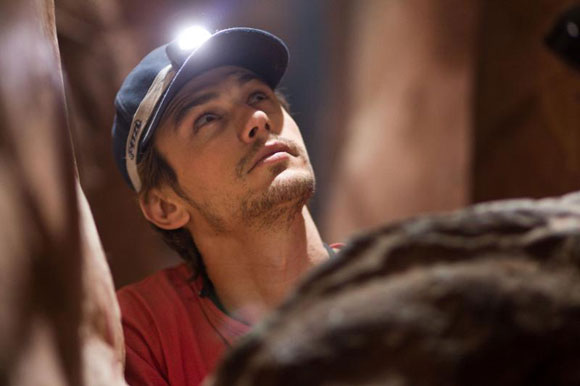127 Hours

James Franco in Fox Searchlight's 127 HOURS. Photo Credit: Chuck Zlotnick

127 Hours kicks off with a typical Danny Boyle “rhythm of life” sequence borrowed directly from Geoffrey Reggio’s Koyaanisqatsi. From there, however, the clichés end, and begins a test of James Franco’s skills as an actor.
Adapted from his book Between a Rock and a Hard Place, the film tells the story of Aron Ralston’s (Mr. Franco) trek and confinement at Bluejohn Canyon, Utah, where a loose rock fell and pinned his arm. As is to be expected for such stories, we are taken through Aron’s various emotional states of pragmatism, sardonic wit, resignation, desperation, fear, determination and finally liberation.
The ordeal is preceded by his departure over which he later criticizes himself for not having the sense to tell anyone where he was going. He says little to his mother, his boss, and makes off to nearby Horseshoe Canyon some 17 miles away from his fate. At the canyon, he encounters two lost young women and helps them navigate their way out, but not before taking a dip in an underground lake.
What makes the characterization of Ralston fascinating is not simply the recycling of, inevitably, the stages of coping that mirror other stranded scenarios—e.g. Castaway—but the intensity of Mr. Franco, the cinematography by Anthony Dod Mantle, editing by Jon Harris and A.R Rahman’s score stir up tremendous agitation.
Periodically, writer/director Danny Boyle shifts from Aron’s predicament to flashbacks triggered by his conversations with his video camera. He recalls how foolish it was to not tell anyone where he was going, or that he never returned his mother’s calls—some 21 messages on his answering machine, most of them probably hers. He reflects heavily on his distanced personality and his need for escape, which he now regrets as that blindness to family, friends, co-workers and loved ones has inexorably left him helpless in this situation. In one of the most poignant sequences, he imagines that the rock has been waiting for him all his life.
The complication is Danny Boyle’s penchant for overproduction. While the smash-cut theatrics of David Fincher are appropriate for The Social Network, 127 Hours is weakened a little by it. Granted, attention spans are a rare commodity today. However, a director as serious about art as Mr. Boyle wants to be should resist the temptation to dazzle us and instead rely on superlative storytelling and characterizations—already present in this film, making the Gen-Y editing all the more puzzling.
Yet there is one very jarring sequence I won’t spoil (in case you happen to be eating) that, having had a similar experience myself, I’ll just say it struck a nerve. Mr. Franco drives what might otherwise be an exhausted one-person play. He teeters between therapeutic lightheartedness and dehydrated insanity. Aided by Mr. Boyle’s sometimes overcooked style, Mr. Franco transports us into Ralston’s frame of mind in the five-plus days he remained trapped, surviving on a carefully-rationed 300ml of water and whatever wits he could maintain under such horrifying circumstances.
 127 Hours • Dolby® Digital surround sound in select theatres • Aspect Ratio: 1.85:1 • Running Time: 94 minutes • MPAA Rating: R for language and some disturbing violent content/bloody images. • Distributed by Fox Searchlight Pictures
127 Hours • Dolby® Digital surround sound in select theatres • Aspect Ratio: 1.85:1 • Running Time: 94 minutes • MPAA Rating: R for language and some disturbing violent content/bloody images. • Distributed by Fox Searchlight Pictures
Dolby and the double-D symbol are registered trademarks of Dolby Laboratories.